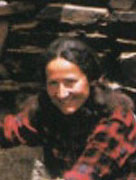Hannelore Schmatz
This article needs to be divided into sections. (January 2016) |
Hannelore Schmatz | |
|---|---|
Hannelore Schmatz | |
 Hannelore Schmatz | |
| Born | 16 February 1940 |
| Died | 2 October 1979 (aged 39) |
| Cause of death | Cold, exhaustion |
| Nationality | |
| Citizenship | |
| Occupation | mountaineer |
| Spouse | Gerhard Schmatz |
Hannelore Schmatz (February 16, 1940 – October 2, 1979) was a German mountaineer. She collapsed and died on October 2, 1979 as she was returning from successfully summiting Mount Everest via the southern route, the first woman and first German citizen to die on the upper slopes of Everest.[1]
Schmatz was on an expedition via the South East Ridge route with her husband when she died at 8,300 metres (27,200 ft). Gerhard Schmatz was the expedition leader, 50 years of age at the time and the oldest man to summit Everest. On the same expedition was the American Ray Genet, who also died while descending from the summit. Exhausted from the climb, they had stopped to bivouac as the night approached, despite the fact that their Sherpa guides had urged them not to. Sungdare Sherpa, one of her Sherpa companions, remained with her after she died, and as a result, lost most of his fingers and toes.[2]
Genet's body ultimately disappeared under the snow, but Schmatz's body was swept further down the mountain.[3]
For years, Schmatz's remains could be seen by anyone attempting to summit Everest by the southern route. Her body was frozen in a sitting position, leaning against her pack with her eyes open and her hair blowing in the wind, about 100 metres above Camp IV.[4]
In 1984, police inspector Yogendra Bahadur Thapa and Sherpa Ang Dorje fell to their deaths while trying to recover Schmatz’s body on a Nepalese police expedition.[5][6]
Chris Bonington spotted Schmatz from a distance in 1985, and initially mistook her body for a tent until he got a closer look.[3]
Lene Gammelgaard, the first Scandinavian woman to reach the peak of Everest, quotes the Norwegian mountaineer and expedition leader Arne Næss, Jr. describing his encounter with Schmatz's remains, in her book Climbing High: A Woman's Account of Surviving the Everest Tragedy (1999), which recounts her own 1996 expedition.[7]
The wind eventually blew Schmatz's remains over the edge and down Kangshung Face.[8]
See also
- List of people who died climbing Mount Everest
- Shriya Shah-Klorfine (Canadian woman who died in 2012 on Everest)
References
- ^
"Everest summiter Hannelore Schmatz". Everest News. Retrieved 2008-04-08.
{{cite web}}: Cite has empty unknown parameter:|coauthors=(help) - ^ http://www.alpine-club.org.uk/alpineclub/AlpineLeafletFull.pdf
- ^ a b Joe Simpson (1997). Dark shadows falling. The Mountaineers Books. pp. 119–. ISBN 978-0-89886-549-3. Retrieved 7 April 2013.
- ^
Gammelgaard, Lene. "Climbing High: A Woman's Account of Surviving the Everest Tragedy". The New York Times. Retrieved 2008-04-08.
{{cite web}}: Cite has empty unknown parameter:|coauthors=(help) - ^
Salkeld, Audrey (1996-05-09). "Report from Base Camp". PBS. Retrieved 2008-04-08.
{{cite web}}: Cite has empty unknown parameter:|coauthors=(help) - ^
"2 Nepalese Mountaineers Die Looking for Body on Everest". The New York Times. 1984-10-29. Retrieved 2008-04-08.
{{cite web}}: Cite has empty unknown parameter:|coauthors=(help) - ^ Gammelgaard, Lene (1999). Climbing High: A Woman's Account of Surviving the Everest Tragedy.
- ^ David Breashears (1 May 1999). High exposure: an enduring passion for Everest and unforgiving places. Simon & Schuster. ISBN 978-0-684-85361-1. Retrieved 7 April 2013.
